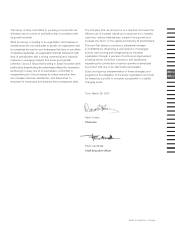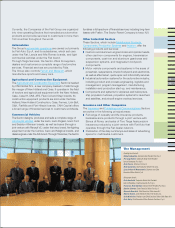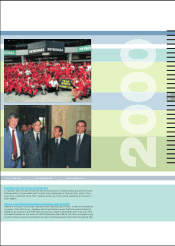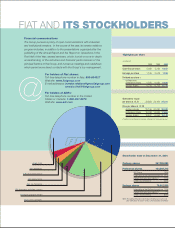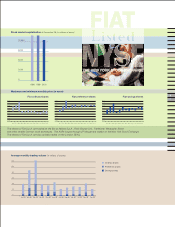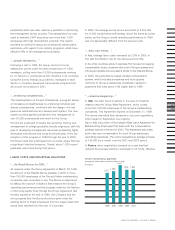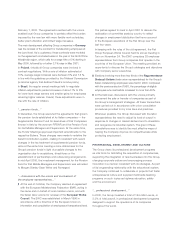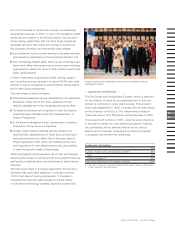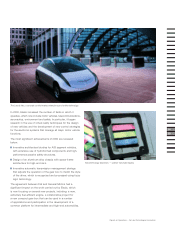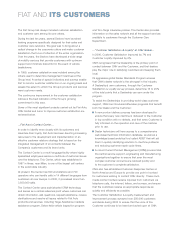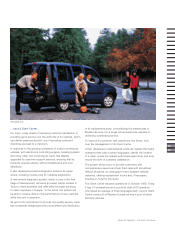Chrysler 2000 Annual Report Download - page 24
Download and view the complete annual report
Please find page 24 of the 2000 Chrysler annual report below. You can navigate through the pages in the report by either clicking on the pages listed below, or by using the keyword search tool below to find specific information within the annual report.
Report on Operations – Fiat and its People
Leadership skills were also used as a yardstick in refocusing
the management review process. This assessment tool was
used to evaluate 2,900 executives and more than 1,000
employees with high development potential. The results
provided an outline for laying out professional career paths,
particularly with regard to job mobility programs, which have
affected 16% of the management population.
“…people satisfaction…”
Following a test in 1999, the Group carried out a job
satisfaction survey under the direct supervision of 1,800
managers, polling more than 18,000 professionals working
for 21 Sectors or companies at 291 locations in 24 countries.
Using the survey findings as guidelines, managers in each
Sector or company developed improvement programs that
will be put into practice in 2001.
“…enhancing competencies…”
The implementation of Project Professional, a program aimed
at increasing competitiveness by enhancing individual and
shared competencies, continued with the design of a new
personnel administration and development system. The new
system is being applied worldwide to the management of
over 30,000 professionals who work for the Group.
Fiat Gra.De continued to handle the recruiting, training and
management of college graduates (mostly engineers), with the
goal of developing management resources possessing highly
developed international and cross-functional skills. From the
inception of this program in 1998 through the end of 2000,
the Group hired 230 employees from countries where Fiat has
a significant industrial presence. Overall, about 1,500 recent
graduates were hired during that period.
LABOR COSTS AND INDUSTRIAL RELATIONS
“…the Result Bonus for 2000…”
As required under the Group Agreement of March 18, 1996,
the amount of the Results Bonus payable in 2000 to more
than 100,000 employees of the Group’s Italian metalworking
companies was computed in July. The Bonus is determined
by taking into account indicators that measure the Group’s
operating performance and the progress made by the Sectors
in improving quality. Even though the Group Agreement had
formally expired at the end of 1999, the Company and the
unions agreed that the Bonus should be paid under the
existing terms to shield employees from the wage losses that
would have resulted from the lack of a contract.
In 2000, the average annual bonus amounted to 2,633,000
lire (1,360 euros) before withholding, about the same as a year
earlier, as the Group’s overall operating performance in 1999
was not appreciably different from the previous year.
“…labor cost trends…”
In Italy, average labor costs increased by 2.9% in 2000, in
line with the inflation rate for the same period (2.5%).
In the other countries where it operates, Fiat focused on keeping
compensation levels consistent with cost-of-living increases and
introduced variable bonus systems similar to the Results Bonus.
In 2000, the performance-based variable compensation
system, which includes procedures and tools applied
uniformly to Group professionals worldwide, resulted in
payments that were about 10% higher than in 1999.
“…collective bargaining…”
In Italy, the main focus of activity in the area of industrial
relations was the Group-Wide Agreement, which covers
more than 100,000 employees of the Group’s metalworking
companies. This Agreement expired on December 31, 1999.
The unions submitted their demands in July and negotiations,
which began in September, are ongoing.
Also in Italy, the portion of the Industry-Wide Labor Agreement for
Metalworking Employees that deals with the compensation
package expired at the end of 2000. This Agreement sets basic
work rules and compensation for most Group employees
(excluding executives). The unions requested an average increase
of 135,000 lire a month over the 2001 and 2002 period.
In France, labor negotiations focused on a new law that
reduced the average statutory workweek to 35 hours, effective 29
28
0
1
2
3
4
5
6
7
8
9
10
11
12
13
14
15
16
17
18
19
20
21
22
23
24
25
26
27
Trend in results bonus payments
(average for white collars and blue collars in Italy)
(in euros)
1999
1,355
199819971996
1,541
1,293
1,227
1,360
2000


